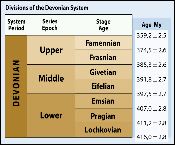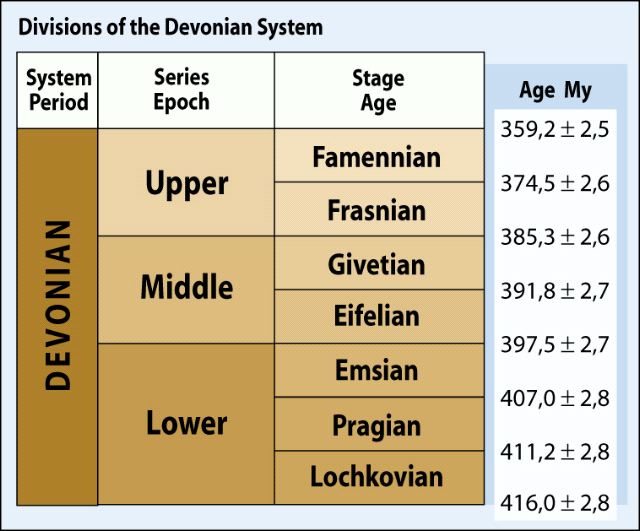The history of the Devonian System
During the first decades of the 19th century, geologists enthusiastically surveyed the British Isles and continental Europe in the hope of discovering fossils and assigning relative ages to the sedimentary layers that contained them.
 (60 kb) Gradually, the names of famous divisions in the geologic timescale began to emerge – like the Cambrian, Silurian, Carboniferous, Jurassic and Cretaceous periods – and these were named after historical or contemporary regions where the rocks of that period are plentiful (Cambria and Jura, for example), or where the rocks reflect the dominant characteristics of the time (“Age of Coal”, “Age of Chalk”, etc.). The geological timescale was finally, albeit slowly, taking shape.
(60 kb) Gradually, the names of famous divisions in the geologic timescale began to emerge – like the Cambrian, Silurian, Carboniferous, Jurassic and Cretaceous periods – and these were named after historical or contemporary regions where the rocks of that period are plentiful (Cambria and Jura, for example), or where the rocks reflect the dominant characteristics of the time (“Age of Coal”, “Age of Chalk”, etc.). The geological timescale was finally, albeit slowly, taking shape.
The famous Scottish writer Hugh Miller (1802-1856), who popularized geology, was particularly interested in a sedimentary formation found in Wales, Scotland and Northern Ireland. Known as the Old Red Sandstone, this formation contains numerous fossils of ancient fish. Around 1830, it was thought that these sedimentary layers dated back to the beginning of the Carboniferous Period. For Hugh Miller, a creationist who nonetheless accepted that our planet and the life it supported had long histories, these fossils represented the first fishes ever created.
At that time, all animals of the Carboniferous were considered to be descendents of Silurian fauna. But geologists studying marine fossils in southern Devonshire County could not agree on their ages. After several years of research and comparisons with various sites in Europe and elsewhere, the evidence was clear that a new stratigraphic system must be inserted between the Silurian and Carboniferous. Thus, in 1839, Devonshire inspired Adam Sedgwick and Roderick Murchison to name this new period the Devonian.
It was still not understood that the Old Red Sandstone was the terrestrial equivalent of the Devonian marine layers in southwestern England, and it took many more studies and discussions before the equivalence of these Devonian layers could be established. Strangely, the decisive argument that ended the controversy was the discovery by Louis Agassiz of a fish scale in a marine limestone under a Carboniferous layer in Belgium that was identical to scales from the fish Holoptychius, already discovered in the Old Red Sandstone in Scotland (and later at Miguasha). Some fossiliferous Devonian layers in North America bear a remarkable resemblance to the continental Old Red Sandstone, such as the Catskill Formation in western Pennsylvania, and the Escuminac Formation at Miguasha.

 (60 kb) Gradually, the names of famous divisions in the geologic timescale began to emerge – like the Cambrian, Silurian, Carboniferous, Jurassic and Cretaceous periods – and these were named after historical or contemporary regions where the rocks of that period are plentiful (Cambria and Jura, for example), or where the rocks reflect the dominant characteristics of the time (“Age of Coal”, “Age of Chalk”, etc.). The geological timescale was finally, albeit slowly, taking shape.
(60 kb) Gradually, the names of famous divisions in the geologic timescale began to emerge – like the Cambrian, Silurian, Carboniferous, Jurassic and Cretaceous periods – and these were named after historical or contemporary regions where the rocks of that period are plentiful (Cambria and Jura, for example), or where the rocks reflect the dominant characteristics of the time (“Age of Coal”, “Age of Chalk”, etc.). The geological timescale was finally, albeit slowly, taking shape.The famous Scottish writer Hugh Miller (1802-1856), who popularized geology, was particularly interested in a sedimentary formation found in Wales, Scotland and Northern Ireland. Known as the Old Red Sandstone, this formation contains numerous fossils of ancient fish. Around 1830, it was thought that these sedimentary layers dated back to the beginning of the Carboniferous Period. For Hugh Miller, a creationist who nonetheless accepted that our planet and the life it supported had long histories, these fossils represented the first fishes ever created.
At that time, all animals of the Carboniferous were considered to be descendents of Silurian fauna. But geologists studying marine fossils in southern Devonshire County could not agree on their ages. After several years of research and comparisons with various sites in Europe and elsewhere, the evidence was clear that a new stratigraphic system must be inserted between the Silurian and Carboniferous. Thus, in 1839, Devonshire inspired Adam Sedgwick and Roderick Murchison to name this new period the Devonian.
It was still not understood that the Old Red Sandstone was the terrestrial equivalent of the Devonian marine layers in southwestern England, and it took many more studies and discussions before the equivalence of these Devonian layers could be established. Strangely, the decisive argument that ended the controversy was the discovery by Louis Agassiz of a fish scale in a marine limestone under a Carboniferous layer in Belgium that was identical to scales from the fish Holoptychius, already discovered in the Old Red Sandstone in Scotland (and later at Miguasha). Some fossiliferous Devonian layers in North America bear a remarkable resemblance to the continental Old Red Sandstone, such as the Catskill Formation in western Pennsylvania, and the Escuminac Formation at Miguasha.
Site map | Feedback | Links | Sources | Credits
The history of the Devonian System
<< The notion of geologic time | Witnesses to evolution >>



